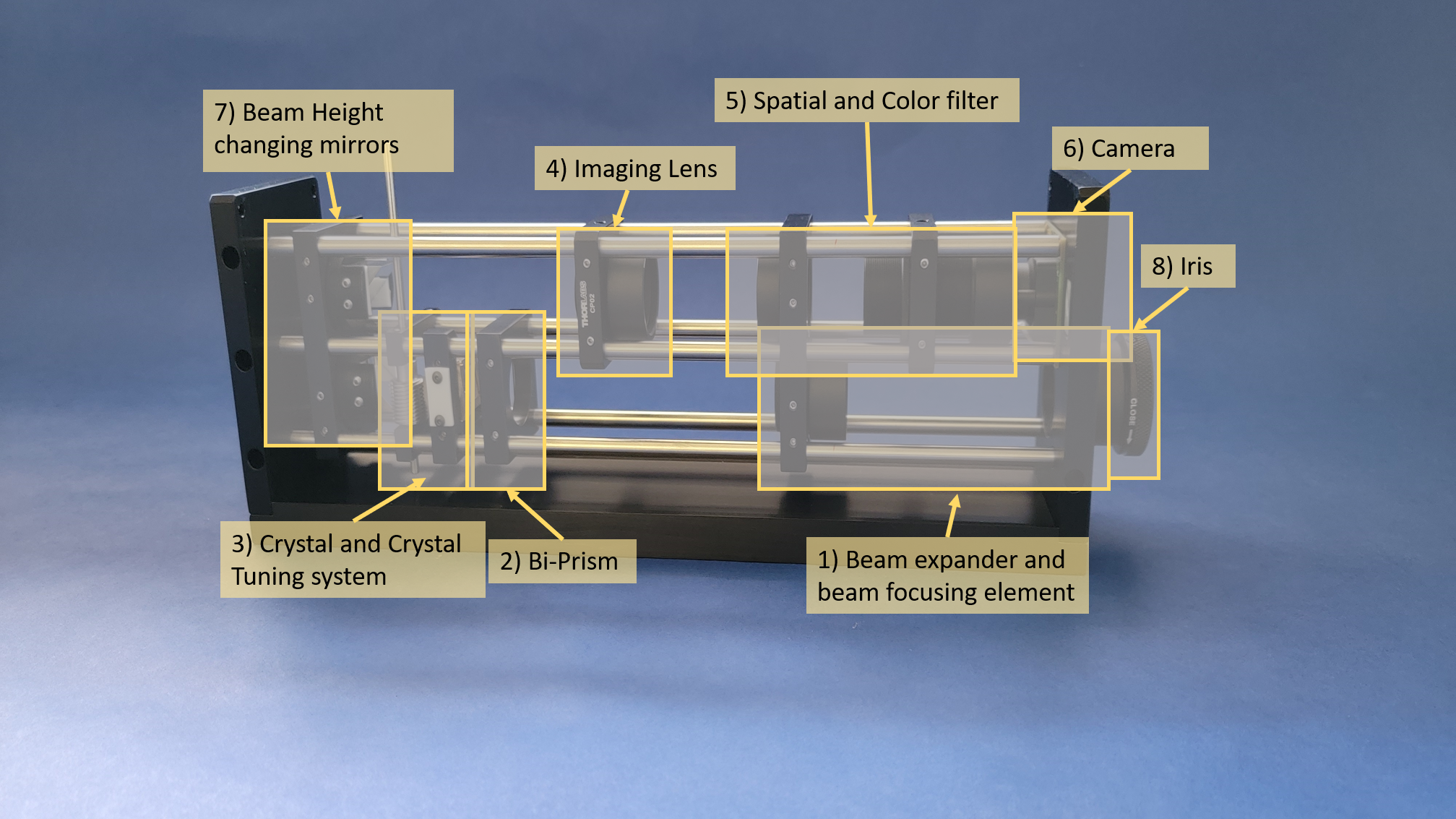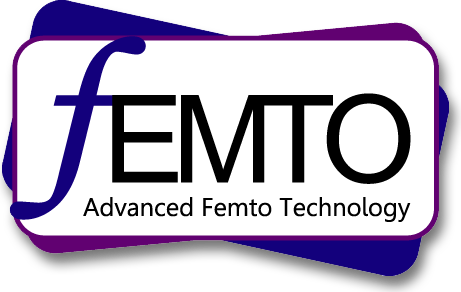Devices for measuring pulses in the near IR range(~800nm)
Standard models AFT 800SFS and AFT 800LPS typically measure pulses from a Ti:sapphire mode-locked oscillator/amplifier system
that generates ultrashort pulses with a duration of between 70 femtoseconds and a few picoseconds. In most cases, the pulse repetition rate is
about ~kHz to ~100MHz (Even ~GHz). The models also measure pulses from an ultrafast fiber laser system whose wavelength typically ranges
between 750nm and 860nm. (The models are able to measure pulses between 750nm and 950nm.)
Using a single-shot FROG geometry, the models are able to take true single-shot measurements of pulses with a triggering system.
In general, for a true single-shot measurement, pulses should be emitted from an amplifier system with a 1kHz or less repetition rate, say,
one pulse or so per hour. In addition, the single-shot measurement technique can measure other pulse distortions (e.g., spatial chirp, pulse front tilt)
that originate from a pulse stretcher and/or a pulse compressor in an amplifier system. Pulse distortions can also be caused
by unusual optics elements or pulse control systems.
Specifications of the models for ~800nm pulses
AFT-800SFS
AFT-800LPS
Construct your own device
We provide the parts you need to build one. If you wish to build your own device, you can purchase all the parts.
If your budget is limited, you could also build a device by purchasing one or two key components.
The photograph below should help you determine which parts you will need. Keep in mind, however, that purchasing only a few parts
for building the device requires an understanding of pulse measurement technologies and geometric optics.
Although such information is available on the web or from the papers related to FROG techniques, you may want to build the device quickly,
or you may find the information insufficient. In such a case, we can help you.

The above photo depicts the path of a beam of an AFT single-shot FROG device. In general, IR or near IR ultrashort pulses enter the device (from the right, as shown by the red arrow). The beam will expand from 4 to 10 times and pass through a bi-prism. Then two replicas are generated, crossed, and focused in a second harmonic generation crystal. The signal, which should be either blue or green, originates from the center of the crystal and passes through several optical elements for imaging and filtering. Only a well-prepared signal will reach a camera chip and create a spectrogram, called a FROG trace.

The photograph illustrates the location of the parts, each of which is described below:
1) The beam expander and focusing element: The size of the beam from an ultrashort pulse system is about 1mm.
As 1mm is not sufficient to generate a temporal delay in the crystal, it must increase from 4 to 10 times this size,
depending on the size of the beam and the duration of the pulse. Then a convex lens, preferably a cylindrical lens,
focuses the beam. (If the pulse comes from an amplifier, the size of the beam could be large enough to measure directly.
If you think the duration of a pulse might be long, the size of the beam should be larger.)
2) Bi-prism: This element generates two beam replicas and makes the two beams cross in the crystal.
The apex angle of the bi-prism is determined by the size of the beam and the duration of the pulse.
The smaller the apex angle is, the longer the pulse duration is covered.
3) Crystal and crystal tuning system: The two replicas are crossed and focused in the crystal,
and then the second harmonic crystal generates the FROG signal. As the strength of the signal depends on the angle of the crystal,
the user needs to control the angle of the crystal carefully. In general, we use a BBO crystal or an LiIO3 as the second harmonic crystal.
4) Imaging lens: This special imaging lens accurately maps a FROG signal emitted from the crystal at a vertical angle to the camera.
The horizontal axis corresponds with a delay in the spectrogram.
5) Spatial and color filter: In general, as the FROG signal is much weaker than the other second harmonic generation and the fundamental beam,
filtration by the spatial and color filter is crucial for acquiring a decent FROG trace.
6) Camera: This is a two-dimensional camera on which the imaging lens maps the
It shows the spectrogram, this is, the FROG trace. If the signal spectrum includes the UV part,
then should use a UV camera instead of a normal CCD camera.
7) Beam height changing mirror: If you want a two-level device similar to the one shown in the photograph,
you must have a pair of the mirrors. If you build a one-level device, however, then you do not need two mirrors.
8) Iris: This element is for beam alignment. With the iris,
you can ensure that the beam hits the center of one of the lenses in the beam expander.
Specifications or requirements for the optics elements, the camera, and the crystal.
| Parts | Specifications or requirements | Coating |
|---|---|---|
| 1) The beam expander and focusing elements |
½”, -25mm, N-BK7, PCC, Sph 1”, 125mm, N-BK7, PCV, Sph 1”, 100mm, N-BK7, PCV, Cyl (Or 1”, 150mm, N-BK7, PCV, Cyl) |
800nm |
| 2) Bi-prism | 1” square, N-BK7, 170˚ apex angle | |
| 3) Crystal and crystal tuning system |
4mmX10mmX3.5mm thick BBO Cut for 800nm |
400nm, 800nm |
| 4) Imaging lens | X-axis: 1”, 100mm, Fused silica, PCV, Cyl Y-axis: 1”, 50mm, Fused silica, PCV, Cyl |
400nm |
| 5) Spatial and color filter | Blue filter and 1mm slit | |
| 6) Camera: | Monochromatic, USB camera Preferable | |
| 7) Beam height changing mirror | A Pair of 15mm right angle prism mirrors | Aluminum coating (UV Enhanced) |
Parts ATF can supply.
| images | What is in the package? | Range (spectral temporal) | Price | |
|---|---|---|---|---|
| AFT-800SFS kit | All the parts and the frame and the cover | 700nm~900nm, 70fs ~1ps | $3500 | |
| 1) The beam expander and focusing element |
Including the lens holders, the lens tubes and the cage plate (30mm) |
700nm~900nm | $500 | |
| 2) Bi-prism | Including the cage plate (30mm) | 700nm~900nm, 70fs ~ 1ps | $500 | |
| 3) Crystal and crystal tuning system | Including the angle tuning system for 30mm cage system |
700nm~900nm, 70fs ~ 1ps | $1700 | |
| 4) Imaging lens | Including the lens tubes and the cage plate (30mm) |
300nm~500nm, 70fs ~ 1ps | $500 | |
| 5) Spatial and color filter | Including the cage plate (30mm adjustable) | $500 | >||
| 6) Camera | Including the mount | Sensitive for 400nm | $500 | |
| 7) Beam height changing mirror | Including the mirror mounts and the tuning units | UV enhanced mirrors | $450 |
For detailed images of the parts, please click on the small images above. This will help you see how they look like. Also, this will help you determine which parts you have on hand
in your optics lab to build the device and which ones that we will supply. A note of caution: Read the specifications carefully
because using the wrong part could cause serious problems.
Shipping and handling fees separately.
For detailed information about the part shipping and handling, PLEASE email us: support@AdvancedFemtoTech.com or info@AdvancedFemtoTech.com









